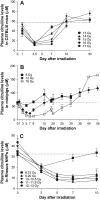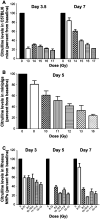Citrulline as a Biomarker for Gastrointestinal-Acute Radiation Syndrome: Species Differences and Experimental Condition Effects
- PMID: 27351760
- PMCID: PMC4976929
- DOI: 10.1667/RR14305.1
Citrulline as a Biomarker for Gastrointestinal-Acute Radiation Syndrome: Species Differences and Experimental Condition Effects
Abstract
Animal models of hematopoietic and gastrointestinal acute radiation syndromes (ARS) have been characterized to develop medical countermeasures. Acute radiation-induced decrease of intestinal absorptive function has been correlated to a decrease in the number of intestinal crypt cells resulting from apoptosis and enterocyte mass reduction. Citrulline, a noncoded amino acid, is produced almost exclusively by the enterocytes of the small intestine. Citrullinemia has been identified as a simple, sensitive and suitable biomarker for radiation-induced injury associated with gastrointestinal ARS (GI-ARS). Here we discuss the effect of radiation on plasma citrulline levels in three different species, C57BL/6 mice, Göttingen minipigs and rhesus nonhuman primates (NHPs), measured by liquid chromatography tandem mass spectrometry (LC-MS/MS). The effects of experimental study conditions such as feeding and anesthesia were also examined on plasma citrulline levels in the NHPs. Both the mice and Göttingen minipigs were partial-body irradiated (PBI) with doses from 13-17 Gy and 8-16 Gy, respectively, whereas NHPs were total-body irradiated (TBI) with doses from 6.72-13 Gy. Blood samples were taken at different time points and plasma citrulline levels were measured in the three species at baseline and after irradiation. Basal plasma citrulline concentrations (mean ± SEM) in mice and minipigs were 57.8 ± 2.8 μM and 63.1 ± 2.1 μM, respectively. NHPs showed a basal plasma citrulline concentration of 32.6 ± 0.7 μM, very similar to that of humans (∼40 μM). Plasma citrulline progressively decreased after irradiation, reaching nadir values between day 3.5 and 7. The onset of citrulline recovery was observed earlier at lower radiation doses, while only partial citrulline recovery was noted at higher radiation doses in minipigs and NHPs, complete recovery was noted in mice at all doses. Plasma citrulline levels in NHPs anesthetized with ketamine and acepromazine significantly decreased by 35.5% (P = 0.0017), compared to unanesthetized NHPs. In the postprandial state, citrulline concentrations in NHPs were slightly but significantly decreased by 12.2% (P = 0.0287). These results suggest that plasma citrulline is affected by experimental conditions such as anesthesia and feeding.
Figures





References
-
- Weiss G, Goodnough LT. Anemia of chronic disease. N Engl J Med. 2005;352:1011–23. - PubMed
-
- Crenn P, Coudray-Lucas C, Thuillier F, Cynober L, Messing B. Postabsorptive plasma citrulline concentration is a marker of absorptive enterocyte mass and intestinal failure in humans. Gastroenterology. 2000;119:1496–505. - PubMed
Publication types
MeSH terms
Substances
Grants and funding
LinkOut - more resources
Full Text Sources
Other Literature Sources

